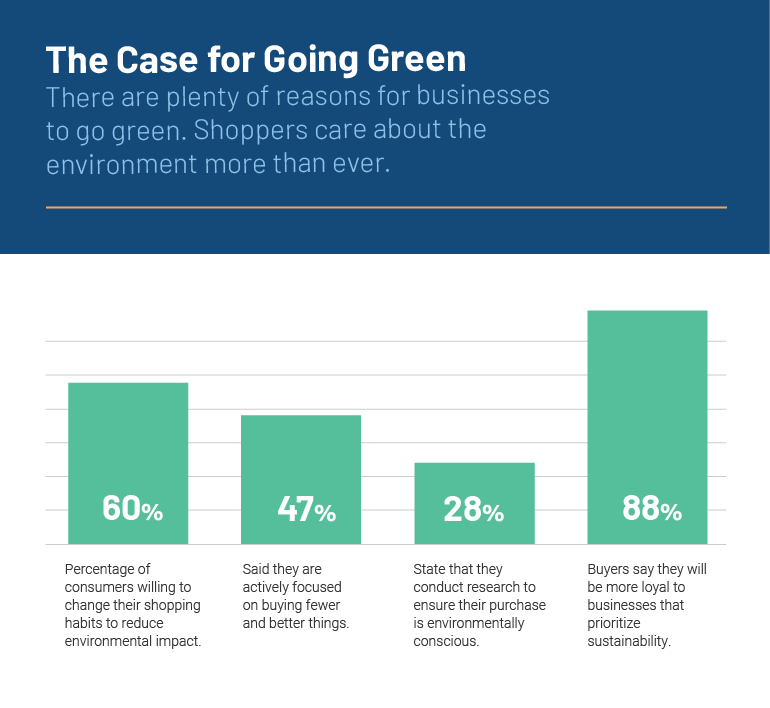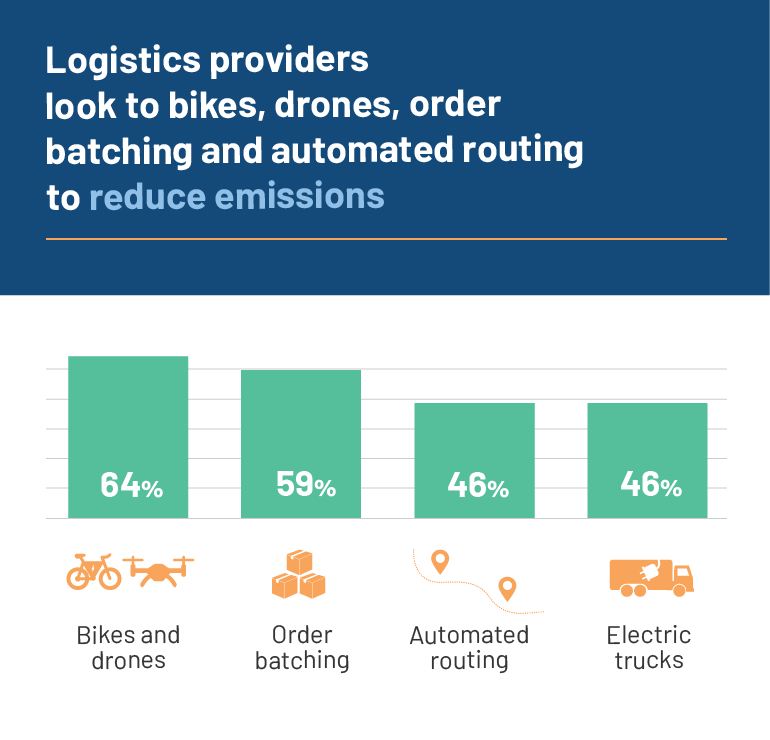
What is Green Logistics?
Time to read: 6 minutes
Green logistics is more than just a talking point among industry leaders. Modern consumers increasingly favor companies and merchants striving to lessen their environmental impact.
According to the 2022 IBM Research Insights report, about 4 out of 5 buyers mention sustainability, health, and wellness when selecting a brand. Businesses are changing their supply chains and logistics frameworks to fulfill these new demands. As more CEOs place sustainability higher in their company priorities, that transformation is gradually taking place.
Integrating environmental concerns into the logistics process is referred to as green logistics. This strategy analyzes and employs effective and sustainable supply chain management techniques to reduce the ecological impact of logistical activities. Of course, these changes must also maintain maximum efficiency and effectiveness.
It is sometimes called “Eco-logistics,” with many logistics managers looking for sustainable ways to reduce overhead expenses and carbon impact.
More people are now purchasing their daily necessities online thanks to the growth of online sales and delivery services in recent years. These purchases can require transferring from one country to another, lengthening the supply chain, and requiring more logistics. All of these processes impact the environment, increasing emissions and pollution levels.
Facing this dilemma, preserving and protecting the environment is now more important than ever. That is the aim of green logistics. The best way to move goods and information from one place to another has traditionally been the main objective of logistics. Reducing the amount of fuel consumed is a common strategy that is thought to be “eco-friendly.” Many companies employ this technique in an attempt to become more sustainable. However, this is insufficient on its own. Green logistics must balance environmental and economic activities to preserve resources and safeguard the environment.
The Importance of Green Logistics in eCommerce
Businesses that switch to greener logistics see improvements in all business areas, including profitability and corporate responsibility. Customer demand is the most impactful factor. Customers (enterprises and consumers) are moving their loyalty to organizations that make major, long-term moves toward a sustainable future. These people witness the effects of climate change daily. Customers and investors will readily support a circular supply chain.

Data Source: https://optimoroute.com/green-logistics/#the-case
Shipping is one of the worst polluters, producing significant greenhouse gas emissions. The World Economic Forum projects a 36% increase in delivery fleets by the end of 2023 in 100 major cities worldwide. This growth is predicted to result in a 30% increase in carbon emissions.
In other words, faster delivery leads to higher traffic volumes and congestion. These are all side effects of consumers wanting their orders to be fulfilled quickly. A significant environmental trade-off exists for businesses attempting to meet customer demands for quick delivery. Most of a company’s overall carbon footprint has emissions from its supply chain. As next-day and same-day delivery become the norm, this will only worsen.
According to a McKinsey analysis on eCommerce in Japan, an 80% increase in deliveries will mean a corresponding 20% increase in CO2 emissions. As many as 71% of routes might be 25% longer by 2030. Currently, some businesses are not utilizing precious space in trucks and vans to prioritize speed above the environment.
Green logistics is one of the many effective programs to combat the deteriorating ecological impact. Analyzing retail supply chains and delivery information across enterprises can be done with the help of modern logistics technologies.
Online merchants should be aware of the significant effects switching to environmentally sustainable solutions or green logistics would have on them.
Reduced Gas Emissions
Reduced greenhouse gas emissions are one of the most important benefits of green logistics. Following environmentally friendly best practices in logistics helps to lower your supply chain’s carbon footprint. This covers everything from cutting down on energy use to improving the efficiency of logistics processes.
Minimize Waste
Waste is reduced with the use of sustainable logistics. Instead of maintaining paper files, most businesses are centralizing and digitizing their documentation, records, and operational data within integrated web systems. Since customer insights, inventory information, and order management are all in one location, operations are streamlined. Keeping records online drastically reduces the amount of paper waste required for manufacturing.
Even practicing proper recycling and switching to renewable resources can have a sizeable impact on your waste management.
Connect with Your Customers
Retail and commercial customers want faster deliveries and the ability to make simple returns. They want to know where their products are in their journey. Consumers care if they were obtained sustainably. Businesses that provide these insights attract new clients and maintain their loyalty.
Stronger Brand Reputation
eCommerce businesses can gain a competitive edge by implementing and publicizing concrete initiatives to improve green logistics in their supply chain management. Customers are already willing to pay extra for goods from companies that use sustainable business strategies. Being an eco-conscious merchant attracts positive attention from potential customers.
Getting Started With Green Logistics
eCommerce merchants of all sizes can gain from embracing green logistics techniques. Common sustainable logistics practices include diversifying product sourcing, increasing warehouse efficiency, and lowering transportation emissions. When used independently or in tandem, these tactics can benefit your entire logistics chain.

Source Ethically
A company’s purchasing and procurement policy may include sustainability criteria when evaluating suppliers’ proposals. The viability of buying eco-friendly goods can be adequately assessed by noting product attributes, manufacturing procedures, and supplier location. Practical applications of this would be working with certified and regulated manufacturers or adopting eco-friendly packaging. A supplier close to your distribution hub can significantly reduce your carbon impact.
Optimize Your Transportation Fleet
Using eco-friendly vehicles like drones and electric cars is a simple solution for a greener supply chain. Although it seems like a straightforward answer, it is quite expensive. Small businesses may not be able to afford these vehicles. Route optimization is an alternative tactic that can significantly increase the sustainability of your deliveries.
The overall fulfillment distance can be decreased with the help of efficient routing. It lowers fuel costs and greenhouse gas emissions. A logistics management system frequently supports route optimization. These programs aid in streamlining last-mile delivery and all phases of order fulfillment, from processing to returns.
Streamline Warehouse Operations
A warehouse that operates 24/7 can rack up some very costly utility bills. Businesses can use a range of green logistics techniques to reduce their energy usage to meet these energy usage issues. One tactic would be investing in renewable energy sources like solar or wind to power your warehouses. A popular strategy that is gaining popularity is the concept of dark warehouses. These distribution centers use AI-powered robots for various tasks and can therefore operate without lights. It’s efficient but also cuts down on electricity costs.
Increase awareness and motivate employees to adopt green behaviors by educating your staff about the value of decreasing your carbon footprint. Establish a waste sorting procedure based on recyclable resources. Promote the reducing, reusing, and recycling of materials.
Reverse Logistics
Reverse logistics refers to returning a product to its origin, usually a warehouse or distribution center, after it has been delivered to a client. You can increase the effectiveness and sustainability of your organization by using a logistics system to manage your reverse logistics. It can also optimize your delivery procedures.
Go Digital
Paper is everywhere in shipments. You’ll find many documents that come with every delivery: order information, invoices, and proof of delivery, to mention a few. A retail or logistics organization can cut down on their paper dependency. With the help of technological developments and modern solutions, businesses can easily digitize all processes. Using online and digital tools, merchants can reduce their reliance on paper and save more trees.
Although only some are implementing green logistics solutions, the eCommerce market is sending a clear message. A business addressing environmental challenges in its supply chain will find that greenness pays off. As companies expand their last-mile logistics operations to meet rising demand, this becomes increasingly crucial.
Businesses must prioritize sustainability in their logistics processes, including technology adoption and working with green partners. Ultimately, this is to establish cost-effective, green logistics successfully. These actions are necessary to have an impact and let stakeholders and customers know about it.
eCommerce companies that adopt eco-friendly practices will be able to not only please customers but also significantly reduce carbon emissions and fuel consumption. Producing energy savings for their business helps leave our world in a better state than it is today.
ZhenHub helps you get started with green logistics by integrating smart solutions into your supply chain. Be more efficient with tech-driven eCommerce fulfillment centers across the globe. Sign up for free and explore our all-in-one logistics platform.